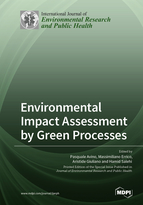Environmental Impact Assessment by Green Processes
A special issue of International Journal of Environmental Research and Public Health (ISSN 1660-4601). This special issue belongs to the section "Environmental Health".
Deadline for manuscript submissions: closed (31 March 2022) | Viewed by 51637
Special Issue Editors
Interests: phthalates; bisphenol-A; plasticizers; microplastics; environment; human health; endocrine disruptors
Special Issues, Collections and Topics in MDPI journals
Interests: design and optimization of separation processes; process synthesis for the separation of multicomponent mixtures; biofuels separation and purification; bio-alcohols; recovery of natural compounds; biowastes
Special Issues, Collections and Topics in MDPI journals
Interests: process optimization; process simulation; mathematical modeling; environmental assessment; biomass valorization; air quality
Special Issues, Collections and Topics in MDPI journals
Special Issue Information
Dear Colleagues,
Primary energy consumption around the world has been increasing steadily since the Industrial Revolution and shows no signals of slowing down in the coming years. This trend is accompanied by the increasing pollutant concentration on the Earth’s biosystems and the general concerns over the health and environmental impacts that will ensue. Air quality, water purity, atmospheric CO2 concentration, etc., are some examples of environmental parameters that are degrading due to human activities. These ecosystems can be safeguarded without renouncing industrial development, urban and economic development through the use of low environmental impact technologies instead of equivalent pollutant ones or through the use of technologies to mitigate the negative impact of high emissions technologies. Pollutant abatement systems, carbon capture technologies, biobased products, etc. need to be established in order to make environmental parameters more and more similar to the pre-industrialization values of the planet Earth. Papers addressing these topics are invited for this Special Issue, especially those combining a high academic standard coupled with a practical focus on green processes and a quantitative approach to environmental impacts.
Prof. Dr. Pasquale Avino
Dr. Massimiliano Errico
Dr. Aristide Giuliano
Dr. Hamid Salehi
Guest Editors
Manuscript Submission Information
Manuscripts should be submitted online at www.mdpi.com by registering and logging in to this website. Once you are registered, click here to go to the submission form. Manuscripts can be submitted until the deadline. All submissions that pass pre-check are peer-reviewed. Accepted papers will be published continuously in the journal (as soon as accepted) and will be listed together on the special issue website. Research articles, review articles as well as short communications are invited. For planned papers, a title and short abstract (about 100 words) can be sent to the Editorial Office for announcement on this website.
Submitted manuscripts should not have been published previously, nor be under consideration for publication elsewhere (except conference proceedings papers). All manuscripts are thoroughly refereed through a single-blind peer-review process. A guide for authors and other relevant information for submission of manuscripts is available on the Instructions for Authors page. International Journal of Environmental Research and Public Health is an international peer-reviewed open access monthly journal published by MDPI.
Please visit the Instructions for Authors page before submitting a manuscript. The Article Processing Charge (APC) for publication in this open access journal is 2500 CHF (Swiss Francs). Submitted papers should be well formatted and use good English. Authors may use MDPI's English editing service prior to publication or during author revisions.
Keywords
- environmental impact
- low emissions processes
- biobased
- carbon capture
- pollution mitigation
- pollutant abatement technologies
- air quality
- carbon footprint
- water footprint
- environmental indicators









